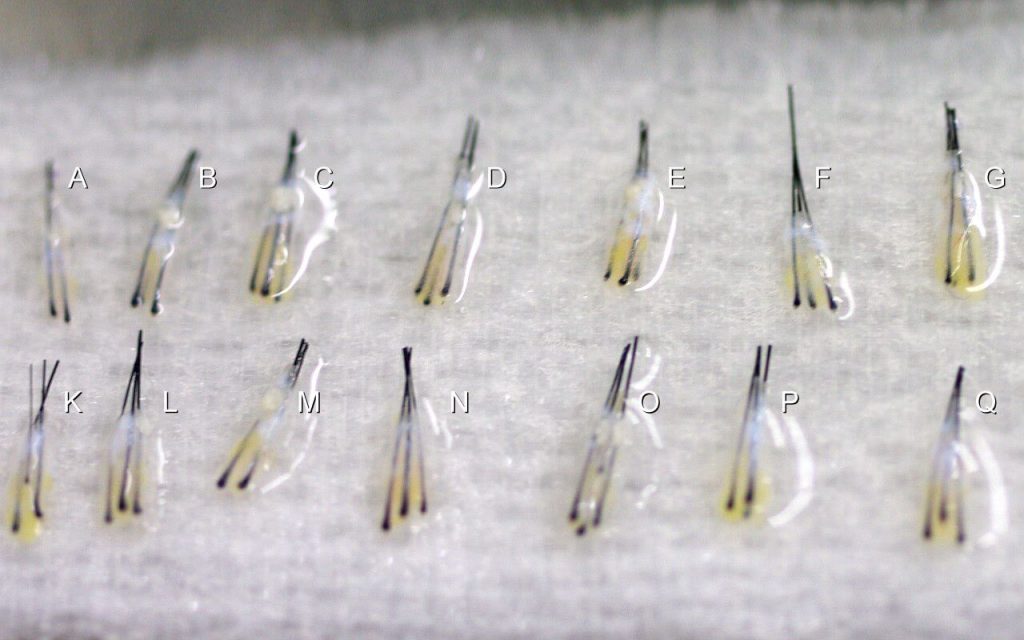- Hotline: 852+ 2891 9689
- Whatsapp: 852+ 9146 8426
- [email protected]
- 6/F 29 Austin Road, Tsimshatsui, Kowloon, Hong Kong
To truly understand how hair transplant works — and why it succeeds — you need to understand the basic building blocks: grafts and follicular units.
Natural Appearance: Using follicular units allows surgeons to mimic natural hair patterns, creating seamless, undetectable results.
Graft Count Matters: Understanding that 2,000 grafts doesn’t mean 2,000 hairs (it could be 4,000+ hairs) helps patients set realistic expectations.
Donor Preservation: Transplanting in follicular units ensures efficient use of limited donor hair, preventing unnecessary wastage.
In short, grafts and follicular units are the foundation of modern hair transplant, shaping everything from surgical planning to final results.

“Follicular Unit” was first described by Dr. John Headington, a pathologist, in his 1984 paper “Transverse microscopic anatomy of the human scalp”. Scalp hair follicles were observed to bind together underneath the skin, emerging from the scalp in clusters or groups of 1-5 hairs in each pore. Each grouping of hair is called a “Follicular Unit” or “FU”.
Follicular Unit Transplant (FUT) is a hair restoration technique where a patient’s hair is transplanted using these naturally occurring follicular units of 1 to 4 hairs. In a properly-performed FUT, the results will mimic the way hair grows in nature and will be undetectable as a hair transplant. These small units allow the surgeon to safely transplant thousands of grafts in a single session, which maximizes the cosmetic impact of the procedure. Procedures using the larger minigrafts often produced a pluggy, unnatural look. Over the last 20 years Minigrafts transplant has been replaced by Follicular Unit Transplant.
Each individual will have a unique combination of 1-Hair FU, 2-Hair FU, 3-Hair FU. For a certain area the average number of hair per FU is known as Hair-Graft Ratio. The Hair-Graft Ratio is different amongst various Ethnic Groups. With a higher FU density and hair-graft ratio, Caucasians are more suitable for FUE.
Caucasian |
Africans |
Asians |
|
|---|---|---|---|
| Hair-Graft Ratio | 2.3 | 2.3 | 1.8 |
The FU density varies amongst different ethnic groups, being highest in Caucasians and lowest in Africans
Caucasian |
Africans |
Asians |
|
|---|---|---|---|
| Hair Density | 200 / sq.cm | 160 / sq.cm | 170 ⁄ sq.cm |
| FU Density | 100 / sq.cm | 60 / sq.cm | 90 / sq.cm |
In order to provide hair transplant service to patients from different ethnic groups, we have studies in depth the differences in their hair density and characters
Caucasian |
Africans |
Asians |
|
|---|---|---|---|
| Hair Density | 200 / sq.cm | 160 / sq.cm | 170 ⁄ sq.cm |
| FU Density | 100 / sq.cm | 60 / sq.cm | 90 / sq.cm |
| Shaft Cross-Section | Oval | Elliptical | Round |
| Shaft Diameter | 0.07 mm | 0.06 mm | 0.08 mm |
| Hair Shape | Curly | Wavy | Straight |
| Length of Follicle | 4.5 mm | - | 5.5 mm |
Usually the density is highest in the mid-occipit which is at the back of the head.
Density (FU/sq.cm) |
Front |
Sides |
Back |
Average |
|---|---|---|---|---|
| Normal Men | 84 | 55 | 80 | 73 |
| Bald Men | 68 | |||
| Women | 87 | 54 | 72 | 72 |
| Bald Women | 69 | |||
The 2 Hair FU is the most common in Chinese, followed by the 1 Hair FU. 4- and 5- Hair FUs are very hard to find.
Ratio (%) |
1 Hair FU |
2 Hair FU |
3 Hair FU |
4 Hair FU |
Hair Graft Ratio |
|---|---|---|---|---|---|
| Men | 29 | 52 | 17 | 2 | 1.92 |
| Women | 33 | 49 | 16 | 2 | 1.87 |

Confusion arises when using different units to estimate the cost of a hair transplant procedure. Over 95% of hair transplant centers worldwide use “graft” as unit to estimate procedural cost. Advance in technology renders the smallest follicular unit to be used as graft. i.e. one graft = one FU. Nowadays 2,000 graft can easily be transplanted in one session.
Some centers however, limited by technique or manpower, may not be able to achieve such numbers. In order to sound good they instead use “hair” as unit. Telling a patient he had 2,000 hairs transplanted seems impressive but that’s in fact just about 1,000 grafts. To avoid confusion ask clearly the unit for calculating cost.
The graft is a living tissue. A lot of things take place after the graft is planted into the new site. Understanding of the natural histochemical process is crucial, as a better graft survival means a better outcome.

After the graft is harvested from the donor area, it is placed in a storage solution for preservation until implanted in the recipient area. Its original blood supply is detached. Oxygen is depleted and waste products begin to accumulate. The ability of the graft to receive nutrients from the recipient site and undergo revascularization (formation of new blood vessels) therefore determines survival.
After the graft is inserted into one of the slits, the wound healing process immediately takes place. There is a cascade of cellular activities – edema (swelling), erythema (redness), hair shedding, new hair formation, and the revascularization of the hair graft.

To truly understand how hair transplant works, it is important to understand the basic building blocks: follicular units, grafts, and how the grafts survive after implantation.

From consultation, surgery, to aftercare, you will receive continued personal care by our doctors, not just consultants.
Have a question? Please feel free to call our friendly customer service.
International Accreditations
Recognized by leading global medical bodies, our clinic stands as one of the most qualified and internationally accredited hair transplant centers in Hong Kong and mainland China. We are proud to uphold the highest standards in medical ethics, safety, and surgical expertise.
Hair transplant is the ultimate solution to restores hair, but not everyone is good candidate.
Our online assessment helps determine if these procedures suit you, saving you time and costs.